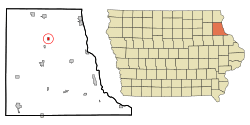Farmersburg, Iowa facts for kids
Quick facts for kids
Farmersburg, Iowa
|
|
|---|---|

Location of Farmersburg, Iowa
|
|
| Country | |
| State | |
| County | Clayton |
| Area | |
| • Total | 0.41 sq mi (1.05 km2) |
| • Land | 0.41 sq mi (1.05 km2) |
| • Water | 0.00 sq mi (0.00 km2) |
| Elevation | 919 ft (280 m) |
| Population
(2020)
|
|
| • Total | 271 |
| • Density | 665.85/sq mi (257.40/km2) |
| Time zone | UTC-6 (Central (CST)) |
| • Summer (DST) | UTC-5 (CDT) |
| ZIP code |
52047
|
| Area code(s) | 563 |
| FIPS code | 19-26850 |
| GNIS feature ID | 0456536 |
Farmersburg is a small city located in Clayton County, Iowa, in the United States. In 2020, about 271 people lived there. This was a bit less than the 300 people who lived there in 2000. The city's mayor is Glenn Radloff. He is also a cross-country truck driver.
Contents
History of Farmersburg
Farmersburg was first surveyed in 1856. Back then, it had a different name: Windsor.
Around 1916, Farmersburg was a busy place. It had three general stores where people could buy almost anything. There was also a bank, a hotel, a grain elevator, and lumber yards.
Geography of Farmersburg
Farmersburg is located in Farmersburg Township. Its exact location can be found using coordinates: 42.958516 degrees north and -91.367555 degrees west.
The United States Census Bureau says that the city covers a total area of about 0.40 square miles (1.05 square kilometers). All of this area is land, with no water.
Population and People
| Historical populations | ||
|---|---|---|
| Year | Pop. | ±% |
| 1900 | 143 | — |
| 1910 | 259 | +81.1% |
| 1920 | 290 | +12.0% |
| 1930 | 275 | −5.2% |
| 1940 | 296 | +7.6% |
| 1950 | 263 | −11.1% |
| 1960 | 250 | −4.9% |
| 1970 | 232 | −7.2% |
| 1980 | 276 | +19.0% |
| 1990 | 291 | +5.4% |
| 2000 | 300 | +3.1% |
| 2010 | 302 | +0.7% |
| 2020 | 271 | −10.3% |
| Source: and Iowa Data Center Source: |
||
2020 Population Count
In 2020, a census counted 271 people living in Farmersburg. There were 108 households and 67 families. A household is a group of people living together in one home.
The city had about 667 people per square mile (257.4 people per square kilometer). There were 125 housing units, which are homes or apartments.
Most of the people in Farmersburg were White (93.7%). A small number were from two or more races (5.9%). About 1.8% of the population was Hispanic or Latino.
Out of the 108 households, about 23% had children under 18 living with them. About half (50.9%) were married couples.
The average age of people in Farmersburg was 38.5 years old. About 25.5% of residents were under 20 years old. About 17.3% were 65 years or older. The city had slightly more males (53.9%) than females (46.1%).
2010 Population Count
In 2010, the census showed that 302 people lived in Farmersburg. There were 126 households and 80 families.
The population density was about 755 people per square mile (291.5 people per square kilometer). There were 133 housing units.
Most people were White (97.0%). About 2.3% were from two or more races. About 0.3% of the population was Hispanic or Latino.
Out of the 126 households, about 34.9% had children under 18. About 52.4% were married couples living together.
The average age in the city was 37.4 years. About 26.8% of residents were under 18 years old. About 14.6% were 65 years or older. The city had slightly more females (51.7%) than males (48.3%).
Education
Students in Farmersburg attend schools within the MFL MarMac Community School District. This school district was formed in 1994. It was created when the Mar-Mac and M-F-L school districts joined together.
Notable Person
- John L. Bascom was an attorney and a representative for Iowa in the state government.
See also
 In Spanish: Farmersburg (Iowa) para niños
In Spanish: Farmersburg (Iowa) para niños


